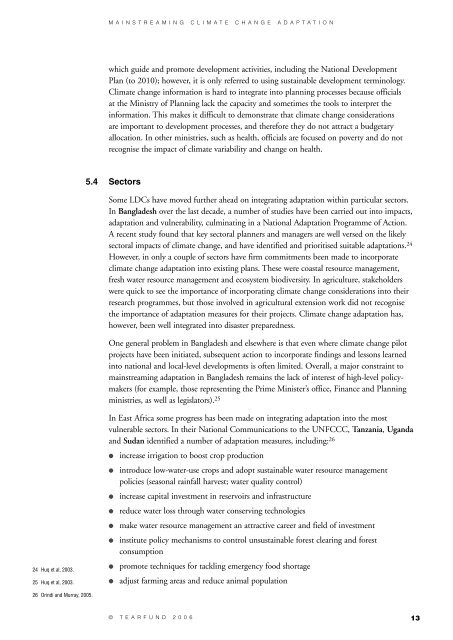Mainstreaming climate change adaptation in developing ... - Tearfund
Mainstreaming climate change adaptation in developing ... - Tearfund
Mainstreaming climate change adaptation in developing ... - Tearfund
Create successful ePaper yourself
Turn your PDF publications into a flip-book with our unique Google optimized e-Paper software.
M A I N S T R E A M I N G C L I M A T E C H A N G E A D A P T A T I O N<br />
which guide and promote development activities, <strong>in</strong>clud<strong>in</strong>g the National Development<br />
Plan (to 2010); however, it is only referred to us<strong>in</strong>g susta<strong>in</strong>able development term<strong>in</strong>ology.<br />
Climate <strong>change</strong> <strong>in</strong>formation is hard to <strong>in</strong>tegrate <strong>in</strong>to plann<strong>in</strong>g processes because officials<br />
at the M<strong>in</strong>istry of Plann<strong>in</strong>g lack the capacity and sometimes the tools to <strong>in</strong>terpret the<br />
<strong>in</strong>formation. This makes it difficult to demonstrate that <strong>climate</strong> <strong>change</strong> considerations<br />
are important to development processes, and therefore they do not attract a budgetary<br />
allocation. In other m<strong>in</strong>istries, such as health, officials are focused on poverty and do not<br />
recognise the impact of <strong>climate</strong> variability and <strong>change</strong> on health.<br />
5.4 Sectors<br />
Some LDCs have moved further ahead on <strong>in</strong>tegrat<strong>in</strong>g <strong>adaptation</strong> with<strong>in</strong> particular sectors.<br />
In Bangladesh over the last decade, a number of studies have been carried out <strong>in</strong>to impacts,<br />
<strong>adaptation</strong> and vulnerability, culm<strong>in</strong>at<strong>in</strong>g <strong>in</strong> a National Adaptation Programme of Action.<br />
A recent study found that key sectoral planners and managers are well versed on the likely<br />
sectoral impacts of <strong>climate</strong> <strong>change</strong>, and have identified and prioritised suitable <strong>adaptation</strong>s. 24<br />
However, <strong>in</strong> only a couple of sectors have firm commitments been made to <strong>in</strong>corporate<br />
<strong>climate</strong> <strong>change</strong> <strong>adaptation</strong> <strong>in</strong>to exist<strong>in</strong>g plans. These were coastal resource management,<br />
fresh water resource management and ecosystem biodiversity. In agriculture, stakeholders<br />
were quick to see the importance of <strong>in</strong>corporat<strong>in</strong>g <strong>climate</strong> <strong>change</strong> considerations <strong>in</strong>to their<br />
research programmes, but those <strong>in</strong>volved <strong>in</strong> agricultural extension work did not recognise<br />
the importance of <strong>adaptation</strong> measures for their projects. Climate <strong>change</strong> <strong>adaptation</strong> has,<br />
however, been well <strong>in</strong>tegrated <strong>in</strong>to disaster preparedness.<br />
One general problem <strong>in</strong> Bangladesh and elsewhere is that even where <strong>climate</strong> <strong>change</strong> pilot<br />
projects have been <strong>in</strong>itiated, subsequent action to <strong>in</strong>corporate f<strong>in</strong>d<strong>in</strong>gs and lessons learned<br />
<strong>in</strong>to national and local-level developments is often limited. Overall, a major constra<strong>in</strong>t to<br />
ma<strong>in</strong>stream<strong>in</strong>g <strong>adaptation</strong> <strong>in</strong> Bangladesh rema<strong>in</strong>s the lack of <strong>in</strong>terest of high-level policymakers<br />
(for example, those represent<strong>in</strong>g the Prime M<strong>in</strong>ister’s office, F<strong>in</strong>ance and Plann<strong>in</strong>g<br />
m<strong>in</strong>istries, as well as legislators). 25<br />
24 Huq et al, 2003.<br />
25 Huq et al, 2003.<br />
In East Africa some progress has been made on <strong>in</strong>tegrat<strong>in</strong>g <strong>adaptation</strong> <strong>in</strong>to the most<br />
vulnerable sectors. In their National Communications to the UNFCCC, Tanzania, Uganda<br />
and Sudan identified a number of <strong>adaptation</strong> measures, <strong>in</strong>clud<strong>in</strong>g: 26<br />
● <strong>in</strong>crease irrigation to boost crop production<br />
● <strong>in</strong>troduce low-water-use crops and adopt susta<strong>in</strong>able water resource management<br />
policies (seasonal ra<strong>in</strong>fall harvest; water quality control)<br />
● <strong>in</strong>crease capital <strong>in</strong>vestment <strong>in</strong> reservoirs and <strong>in</strong>frastructure<br />
● reduce water loss through water conserv<strong>in</strong>g technologies<br />
● make water resource management an attractive career and field of <strong>in</strong>vestment<br />
● <strong>in</strong>stitute policy mechanisms to control unsusta<strong>in</strong>able forest clear<strong>in</strong>g and forest<br />
consumption<br />
● promote techniques for tackl<strong>in</strong>g emergency food shortage<br />
● adjust farm<strong>in</strong>g areas and reduce animal population<br />
26 Or<strong>in</strong>di and Murray, 2005.<br />
© T E A R F U N D 2 0 0 6<br />
13












![View full document [PDF 988.55 KB] - PreventionWeb](https://img.yumpu.com/47733942/1/184x260/view-full-document-pdf-98855-kb-preventionweb.jpg?quality=85)
![View full document (in French) [PDF 4.96 MB] - PreventionWeb](https://img.yumpu.com/47223870/1/184x260/view-full-document-in-french-pdf-496-mb-preventionweb.jpg?quality=85)


![View full document [PDF 25.02 MB] - PreventionWeb](https://img.yumpu.com/44204570/1/190x234/view-full-document-pdf-2502-mb-preventionweb.jpg?quality=85)
